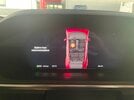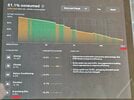Looks like the BMS is about spot on.
60 km might be a little on the low side, I guess. I would prefer to see 150km or 100 miles driven. Just using the SOC/range we probably need a longer drive.
It probably also is better to drive at a decent speed and not too fast.
I have done all my checks on drives to the work, 240km.
But even with only 60km driven, if we see a change in range after the drive it is a indication as from the describtion below.
If the BMS was way off, it would probably be enough to show if it was over- or underestimating.
In your case, as you ”only” lost 1% after two days, your BMS is probably showing about right.
The basics for this is:
We expect the BMS to be spot on = no change of SOC/displayed range after the sleep.
Range decrease after the sleep = overestimation of the capacity.
Range increases sfyer the sleep = underestimation.
This version is a simplification from doing the same with Scan My Tesla which will give a more precise result. I did a few double checks from the displayed range and they basically show the same result as with Scan My Tesla, but as the resolution is lower, so a longer drive would compensate for this.
——————————————————————
Before the drive, let the car sleep (after the charge etc) to make it record the correct ”true” SOC. This is important as we need a BMS starting the estimation from a correct SOC.
After the drive you should record these numbers after the drive:
-SOC and range (in km) at end of the drive. Take this value asap, before any readjustment happens.
-Used energy for the last drive. The total kWh might be fine but [distance x average consumption] gives a more exact result.
-After the car has been parked/locked/sleeping for 30 minutes or more: -SOC and range (in km).
The change in range (or SOC) after the sleep indicates the BMS capacity estimation error.
Each change in range/km = about 0.15kWh, or the actual constant for your car.
(Used energy +/- delta energy)/(Used energy) = the correction factor for the BMS estimated capacity / range.
For example:
Used energy = 50 kWh
Range decreased from 100 to 93km after the sleep = 7 km delta = 1kWh.
(50-1)/50 = 0.98.
The true capacity is 98% of the BMS estimated capacity.
The BMS is overestimating the capacity if this number is below 1, and underestimating if it’s above 1.
Displayed maximum range or calculated capacity from the energy app can be adjusted by multiplication by the correction factor.
——————————————————————
We expect the change in range to be very low. No change means the BMS is estimating the capacity correct.
I’ll be back later with the use of Scan My Tesla to calculate the capacity.
I have a follow up on this.
I did a 249 km drive today. Not 100% perfect for this but I already has my numbers from doing this before, this calc is to show how it is done.
I had to eat and shop after leaving home so the car was at the city with sentry on for 35 minutes, which use 290W so ~150Wh to add to the drive. The car was charged and slept 1 hour after the charge but before the drive.
This first part is the calculation by having exact values from SMT:
SOC leaving home 78.9 displayed = 79.85% true SOC*.
( SOC2 at arrival = 25.4 = 28.76% true SOC) this SOC is not needed for this, but the slight decrease after the sleep tell us the BMS has a slight overestimation of the capacity.
SOC after 1h sleep = 25.2= 28.57% true SOC.
Its better to multiply the average consumption with the driven miles, gives a more exact number that the total energy which is rounded.
Energy= 50.05 (+ 0.15 for sentry) 50.2kWh
Used true SOC = 79.85% - 28.57% = 51.28% ( = 0.5128 in absolute value)
We did use 50.2 kWh which was 51.28% SOC
TOTAL CAPACITY is 50.2/0.5128 = 97.9 kWh.
Km-calc (without SMT).
The car displayed 142km when arriving and 141km after one hour.

The change in energy for 1 km displayed = 165Wh ( = 0.165kWh) for my MSP.
The used energy is as in the SMT example still 50.2 kWh.
Correction factor: 50.2 / 50.365 = 0.9967.
The cars estimated capacity (from SMT, but can be from displayed max range or energy graph calc): 98.3kWh
98.3 x 0.9967 = 98.0kWh.
After the car had its one hour sleep the BMS nominal full pack was adjusted to 98.1 kWh, so the BMS is on track and also follows my calculation. Last time i did the same drive, the calculation predicted the BMS adjustment to the exact decimal.
At that time the drive was a single drive with no stops etc.
True SOC is calculated by [ (100- displayed SOC) x 0.045 + displayed SOC]
I have done this several times, and with the BMS severely off I predicted that the capacity really was close to 98kWh and that the car would readjust from 95.3 to 98 kWh.
For my M3P, it was severely off about one year ago, showing about 75.7 kWh, and I calculated the capacity to be about 79.0 kWh. I also made a 100-0% drive which showed close to 79.0 kWh capacity, and eventually the BMS readjusted to —> 79.0 kWh.
I’m positive this is a good way to test the capacity of there is any doubt about the capacity, or about the BMS being severely off. It might indicate if it is any idea to perform a BMS calib. or not.






